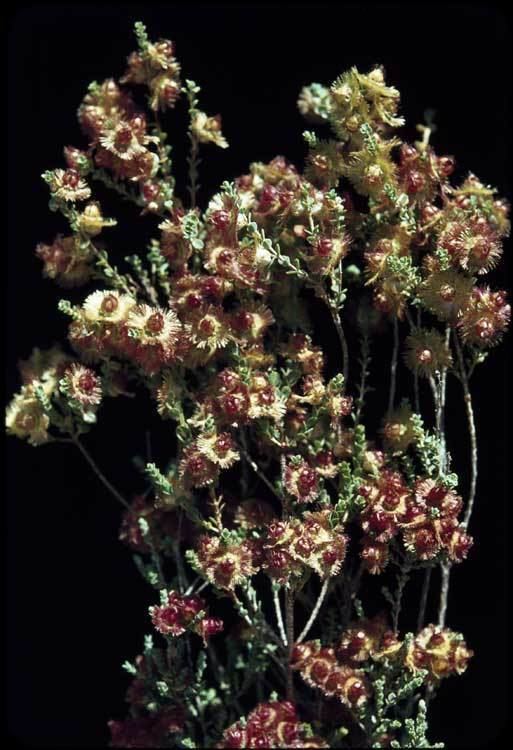Rank Species | ||
 | ||
Similar Verticordia oculata, Verticordia etheliana, Verticordia pennigera, Verticordia grandis | ||
Verticordia dichroma is a flowering plant in the myrtle family, Myrtaceae and is endemic to the south-west of Western Australia. It is a much-branched shrub with rounded leaves and spikes of scented, deep red and golden-coloured flowers.
Contents
Description
Verticordia dichroma is a shrub which grows to a height of 0.3–2 m (1–7 ft) and which has one to a number of stems at its base. The leaves are egg-shaped to almost round, 2–4 mm (0.08–0.2 in) long and often have irregularly toothed margins.
The flowers are scented and arranged in spike-like groups on erect stems 1.5–2 mm (0.06–0.08 in) long and the flowers open at about the same time as each other. The floral cup is top-shaped, about 3 mm (0.1 in) long, has 5 ribs and is glabrous and smooth. The sepals are deep red in colour, or deep red with yellow, 4–5.6 mm (0.16–0.22 in) long, with 10 to 12 feathery lobes. The petals are golden-yellow with red spots, egg-shaped, 5–7 mm (0.2–0.3 in) long, about 2.5 mm (0.1 in) wide with a fringe 1.5–2.5 mm (0.06–0.1 in) long and with deeply-divided, ear-shaped appendages. The style is about 6 mm (0.2 in) long, bent and has long hairs on its sides. Flowering time is from late October to December.
Taxonomy and naming
Verticordia dichroma was first formally described by Alex George in 1991 and the description was published in Nuytsia. The type collection was made by Alex and Elizabeth George "west of [the] North West Coastal Highway, north of No.8 Tank" which is 62 km (40 mi) north of the Kalbarri turnoff. The specific epithet (dichroma) is derived from the Ancient Greek words δίς (dis) meaning "two" and χρομα (khroma) meaning "colour" referring to the two colours of the flowers of this species.
There are two varieties:
George placed this species in Subgenus Eperephes, Section Pennuligera along with V. comosa, V. lepidophylla, V. chrysostachys, V. aereiflora, V. x eurardyensis, V. muelleriana, V. argentea, V. albida, V. fragrans, V. venusta, V. forrestii, V. serotina, V. oculata, V. etheliana and V. grandis.
Distribution and habitat
Both varieties grow in deep sand, often with other verticordias, in heath and shrubland.
Conservation
Both varieties of V. dichroma are classified as "Priority Three" by the Western Australian Government Department of Parks and Wildlife meaning that they are poorly known and known from only a few locations but are not under imminent threat.
Use in horticulture
Both varieties of V. dichroma are worthy of cultivation in gardens due to their spectacular flowers. They are difficult to propagate from cuttings but once established are hardy plants. They are more difficult to grow in eastern Australia.
